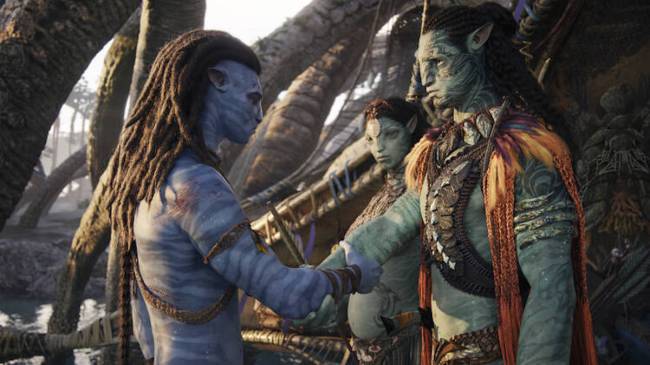Disney
James Cameron is a filmmaking pioneer. That is an indisputable fact, regardless of whatever hot take you harbor about Titanic or Avatar.
More so than his contemporaries — the likes of Stephen Spielberg and Martin Scorsese and Ridley Scott and Quentin Tarantino and David Fincher — the 68-year-old Canadian seems fixated on pushing the technological boundaries of the medium to new heights, or perhaps more aptly, new universes.
He’s done it with the likes of The Terminator and Aliens back in the 80s, with T2 and Titanic in the 90s, and continues to do so to this day with Avatar and its 13-years-in-the-making sequel The Way of the Water, which is absolutely one of the most transformative visual experiences I’ve ever had. If there was *ever* a movie to see in 3D, this is it.

Disney
After walking out of the theater, despite the expectations that come with over a decade of production and anticipation, I felt as though I now — *finally* — understand James Cameron’s obsession with 3D. The man is a pioneer. The problem is, however, that I’m not entirely sure 3D is a frontier worth further exploring, at least as far as movies are concerned. Just because something remains uncharted doesn’t mean it needs to be conquered. Just look at Antarctica and all of its hollow majesty.
Put it this way: about an hour of the film was spent simply admiring the environment he created. While everyone is entitled to have their own desires and tastes when it comes to the cinematic experience — which I consider to be a primarily narrative format — it’s just difficult for me to reconcile that the most impressive part of the film is the way fire under a kettle crackles or how the water in the ocean sways. On one hand, that’s entirely what Cameron is going for. On the other, it’s antithetical to what movies are supposed to be, and that’s a compelling narrative. A movie without a narrative is just a video. A fake yet remarkable fire roasting beneath a pot in the background is, well, just that.
The second act, for example, is basically a repeat of the first film, but *underwater*. It’s an entire re-explanation of the world and how the Na’vi connects and how the animals are all family, or whatever, all so we can admire some sci-fi coral reefs and jellyfish. And on one hand, they look incredible! But, on the other, I’m… bored.
Ultimately, Cameron seems to be more interested in creating new worlds and pushing technological boundaries than anything else. And that is to be admired deeply. But because of that, traditional storytelling elements get lost and you’re ultimately left with a heartless spectacle.

Disney
Which, ironically, is what Marvel has been largely criticized for in recent years. Cameron was able to wring more genuine emotion out of a yolked-up robot than an entire species of aliens. Why? It’s simple. Writing. T-800 is a better-written character in a better-written movie.
Conversely, though, the third act is incredible and the best an Avatar movie has ever been, with the last hour being the closest I’ve come to truly understanding Cameron’s vision for what his brainchild is and can be. And that’s the ultimate conundrum of Cameron’s Avatar endeavor: praise and passion are two different things, the Avatar franchise is all sauce and no soul. Just because you can appreciate something doesn’t mean that you love it.
The Way of Water is an almighty cinematic spectacle that needs to be seen on the biggest screen to be believed. But that’s also, weirdly, all it is. It’s such a singular experience that it’ll be thoroughly and viscerally enjoyed in the moment before it’s likely forgotten mere hours later as it recedes into the memories of moviegoers just like the first one did.
RELATED: Kate Winslet Thought James Cameron Killed Her While Filming Avatar: The Way of Water